Abstract
Background:
The use of social media is growing tremendously along with its impact on the practice of plastic surgery, for better or for worse. Patients are increasingly using social media to obtain information about either the procedure or the surgeon.
Objectives:
The aims of this study were to examine social media posting regarding plastic surgery and to analyze successful online communication methods of the plastic surgeons with the public.
Methods:
A prospective analysis of 3 popular, global social media networks was performed, using the English language key phrases “plastic surgery” and “#plastic_surgery.” Three hundred posts related to plastic surgery published on Instagram, YouTube, and Facebook in November 2017 were assessed by the following parameters: author identity, subject (self-promotion, educational, commercial, and personal posts), “social media currency” (likes, shares, comments, and views), and if special effects (videos, photos, etc.) or viral subjects such as reality stars or shaming were utilized.
Results:
Sixty-three percentage of the posts on Instagram originated with plastic surgeons, compared with 18% on Facebook and only 13% on YouTube (P < 0.01); together, the plastic surgeons’ posts comprise 31% of the total posts, whereas 49% of posts published by commercial companies (P < 0.01). Most of the posts on Instagram were self-promotional (83%), in comparison to Facebook (29%) or YouTube (6%); P < 0.01. YouTube posts are more personal in nature compared with Instagram and Facebook [39%, 7%, 9%, respectively (P < 0.01)]. Educational content in the posts accounts for only 16% of them, P < 0.01. Shaming is seen in 21% of the posts, especially in Facebook (39%), and mainly related to famous public figures (25%); P < 0.05. Celebrity endorsed posts received more attention in every aspect of social media currency (likes, comments, shares, and views). The use of images of women attracts attention and is widely used in social media posts of plastic surgery (68%). Posts that chose to include videos (22%) are generously rewarded. Online shaming also attracts attention, mostly found in Facebook (39%), and mainly of a public figure (25%). The 10 most powerful attention drawing motives were jokes, attractive female plastic surgeons, celebrities, personal stories, provocative surgeries, videos or photos of surgeries, sex, shaming, and patient education.
Conclusion:
Social media have become an important tool for self-promotion and a means to providing better customer service. This trend applies to the plastic surgeon as well. The study’s main insights were to use Instagram, personal stories, educational post, videos and other unique inputs, and involve celebrities in the posts. In general, it would be wise to invest and understand these communication platforms, as they have become the path to dominate the field.
INTRODUCTION
The use of social media (networks) is growing tremendously, and more people are using the internet to obtain information in every aspect of life including medicine and plastic surgery.1,2 Social media is a broad term and may include any of the following: blogs, YouTube, Instagram, Facebook, Twitter, LinkedIn, internet forums, message boards, and more arenas for public interaction, conversation, and sharing. In fact, 95% of plastic surgery patients studied have used the internet as a source of information about their surgeons.3
Plastic surgeons are known to possess qualities such as creativity and adaptability to new techniques and technologies, which are advantageous in the competitive private market.3,4 There is an increase in social media usage by plastic surgeons, but very few know how to effectively utilize it.4,5 In other medical professions, a correlation was found between the age of health care providers and social media use6 with residents’ usage higher than attending physicians.7 This finding might be a factor of novelty, and may erode over time.
Even if plastic surgeons abstain from an active social media presence on Facebook, Twitter, Instagram, etc., they may find themselves there involuntarily through patient-generated reviews and/or complaints. In addition, patient-centered portals and online Recommender Systems like Healthgrades and RateMDs give users the ability to both find and share information about physicians, directly.8,9
In addition, the information on the internet is tendentious and may lack scientific basis, which can lead the patient to erroneous assumptions and unrealistic expectations. Studies have investigated the prevalence of this phenomenon in aesthetic plastic surgery and have shown, for example, that more than a third of the sites that present information about breast augmentation contain false or misleading information.10,11
The competitive market, coupled with the patient’s growing expectation of continuous personal contact,12 poses a challenge to the plastic surgeon. The use of Internet communication can enable the management of contact with patients in a wise and regulated manner.
Various studies have shown that many patients search the web for remedies for their concerns, considering it as the place where an unbiased opinion can be found.13,14
The aims of this study were to examine posting on plastic surgery issues in 3 popular social networks - Instagram, YouTube, and Facebook and to analyze online communication methods of plastic surgeons with the public. The negative influence of social media, in the form of public shaming, has also been addressed, in an effort to evaluate the effect of this phenomena, as the first step in dealing with it in the future, mainly the cons and pros of this popular trend.
METHODS
A prospective analysis of 300 posts in the 3 most popular global social media networks was performed.15 A search for English written posts using the key phrase “Plastic Surgery” was conducted on Facebook and YouTube, and with the hashtag “#plastic_surgery” on Instagram during the second week of November 2017. Exclusion criteria included indecipherable posts, re-posts, and posts unrelated to plastic surgery. The first 100 recent posts on each of the 3 social media platforms that answered the criteria above were selected for a total of 300 posts, a method chosen after consulting a social media expert, and which was similarly applied in other recent studies.5,8,15 Each post was assessed for the following parameters: author identity, subject (self-promotion, educational, commercial, and personal posts), “social media currency” (likes, shares, comments), and for the use of special media (videos, photographs, etc.) or viral subjects (reality stars or shaming). In the last category, we analyzed the reasons that each post attracted attention. Each post was carefully read and reviewed by an experienced social media user and by a social media expert, to distinguish between the posts. A post published by a commercial company was categorized as “commercial,” and a post published by a board-certified plastic surgeon was called “self-promotional.” Data were examined for normal distribution, and parameters were compared between independent groups using the Chi-square test where P < 0.05 was considered statistically significant.
RESULTS
Three hundred posts related to plastic surgery on 3 different popular social media sites, including Facebook, Instagram, and YouTube, were analyzed during the second working week of November 2017.
Author Identity
The distributions of the posts’ authors are presented in Figure 1. Sixty-three percentage of the posts on Instagram were published by plastic surgeons compared with only 18% on Facebook and 13% on YouTube (P < 0.01). Combining the 3 social media sites, plastic surgeons published 31% of the total posts versus 49% by commercial companies (P < 0.01).
Fig. 1.
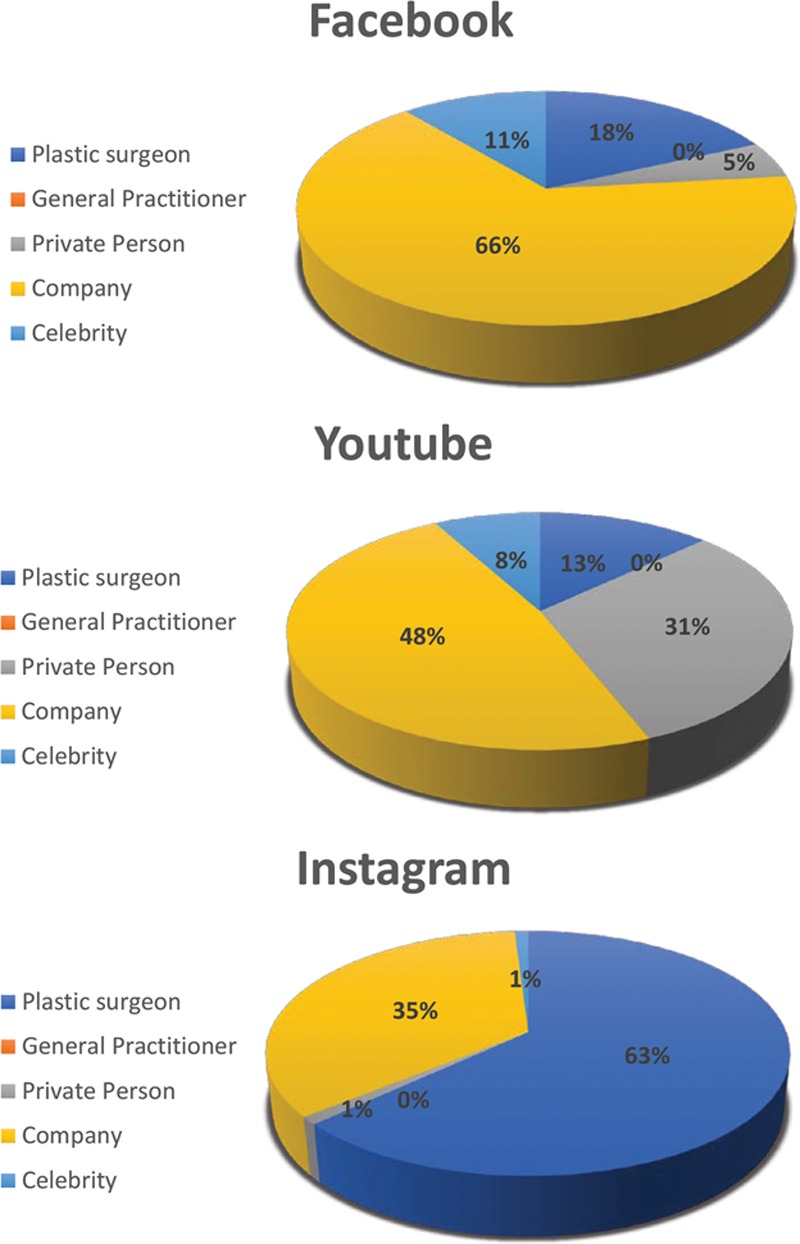
Author identity.
Subject of the Posts
As seen in Figure 2, the majority of posts on Instagram were self-promotional (83%) in contrast to only 29% on Facebook and 6% on YouTube (P < 0.01). YouTube posts were more personal in nature compared with Instagram and Facebook [39%, 7%, and 9%, respectively (P < 0.01)]. Educational content accounted for only 16% of the total posts, and study results were rarely mentioned (2%); P < 0.01.
Fig. 2.
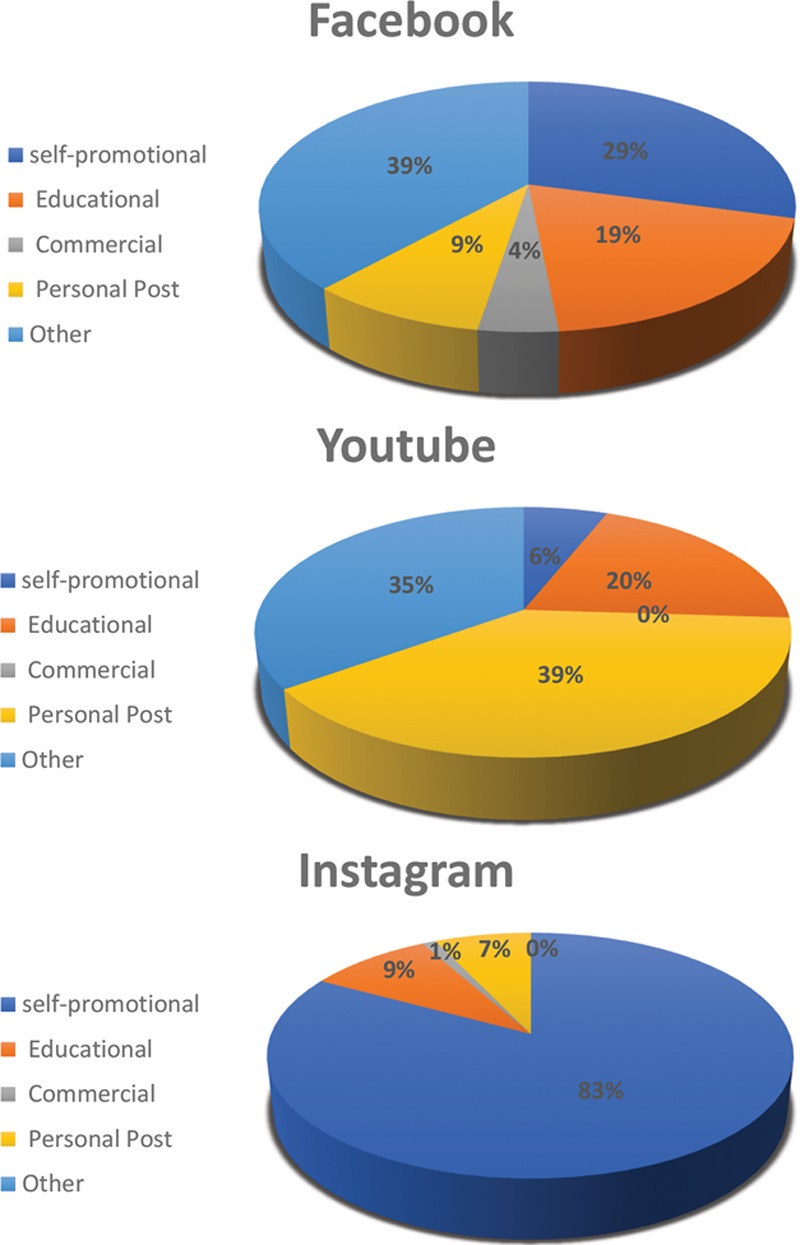
Subject of the posts.
Public Shaming
Online shaming, in which targets are publicly humiliated and criticized, is common and seen in 21% of the posts, mostly in Facebook (39%), and mainly relating to a public figure (more commonly referred as celebrities; 25%); P < 0.05.
For example, post with a picture of a famous man laughing at his many failed plastic surgeries, or posts against plastic surgeons by patients.
Posts Involving a Reality Star
Reality stars are mentioned in 7% of the posts, mainly in Facebook (17%; P < 0.01). It seems that reality stars do get a lot of “likes”, but may not attract attention as effectively (measured by number of comments and views) as other public figures do (Figs. 3, 4).
Fig. 3.

Public shaming.
Fig. 4.
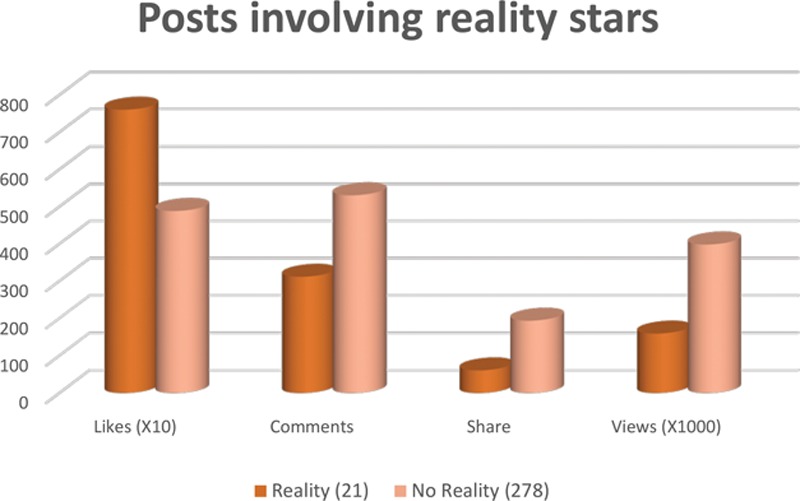
Posts involving reality star.
“Social Media Currency”
As shown in Figure 5, posts involving celebrities received more attention in every aspect (views, likes, comments, and shares). Celebrity posts averaged 28,000 “likes” compared with 1,000 for plastic surgeons, 4,000 for commercial companies, and 6,400 for individuals (“private person”).
Fig. 5.

“Social media currency.”
Based on the data, the “private person” title may be less accurate, because the degree of exposure that some of these private individuals receive suggests that they are well known within their social media networks and may be more accurately labeled “social media celebrities.”
What Attracts Attention?
Celebrities are not the only ones to get attention in social media. There are several ways in which a post can generate interest. For example, images of women in advertisements, which despite being controversial, are also widely used in social media posts about plastic surgery (68% of all posts). Without addressing the problematic nature of this phenomenon, it appears that from a business perspective, the use of a woman’s image is an effective way to attract attention on social media also. This is evident in the enormous amount of views, 336,600 on average, that posts containing images of women received. As for the effectiveness of public education, which will be discussed below, it seems that the educational information regarding surgical procedures was substantially less effective in attracting attention compared with photographs of attractive women (Fig. 6).
Fig. 6.
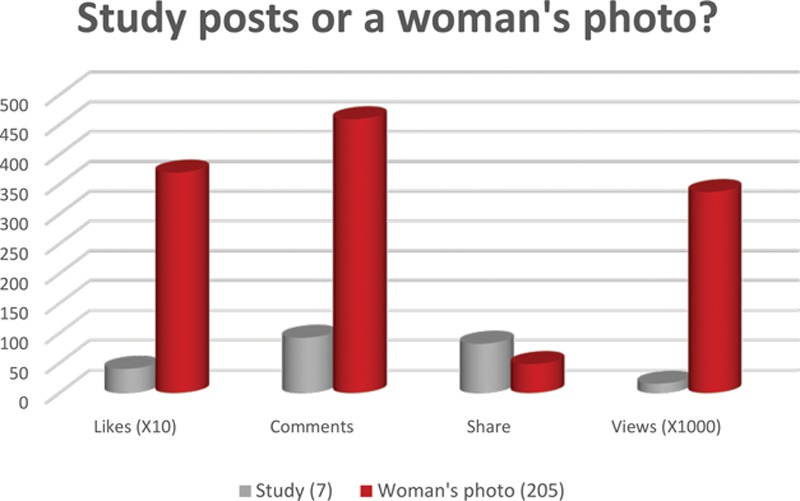
Study posts vs. photographs of women.
As shown in Figure 7, posts that choose to include videos (22%) are generously rewarded; worth noting is the substantial number of shares obtained (763, mean).
Fig. 7.
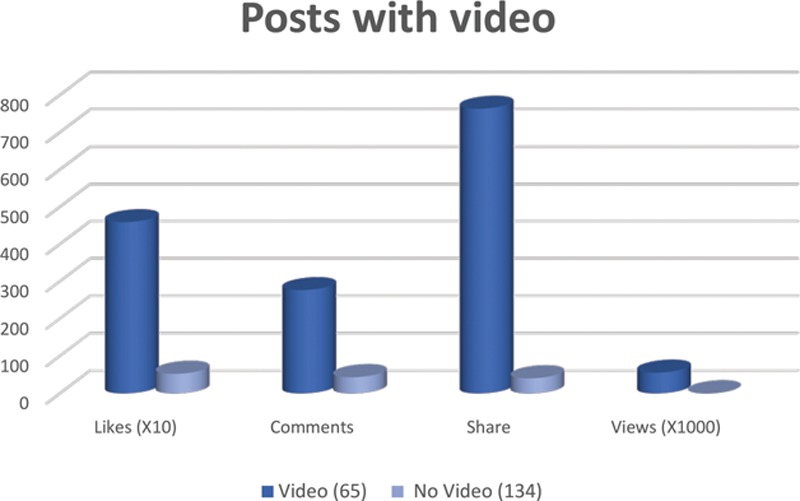
Posts showing videos.
As demonstrated earlier, posts about plastic surgery that included shaming (public humiliation, which may refer to a public figure, a plastic surgeon or a private person) also attracted more attention (likes, comments, and views) but less shares. The majority of shaming posts were on Facebook (39%), and they were mainly about a public figure (25%). It should be noted that plastic surgeons are no strangers to the negative phenomenon of shaming, although mostly occurring in the comments section of the posts and not published directly as a post, hence was not recorded.
The posts have been analyzed and categorized according to the topic that we believe has yielded their broad publicity (may be several topics in each post), as seen in Table 1. Except for an anecdotal invitation for a lecture that gained about 12 million views, the 10 most powerful motives that have gained the attention of the social media audience were jokes, attractive female plastic surgeons, celebrities, personal stories, provocative surgeries, videos or photos of surgeries, sex, shaming, and patient education (Fig. 8).
Table 1.
The Main Attraction of Each Post
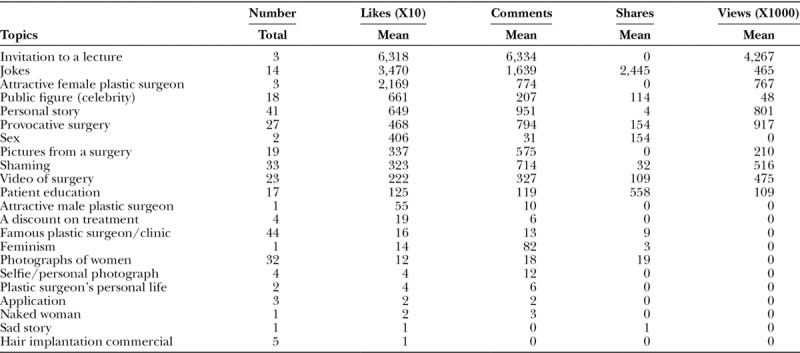
Fig. 8.
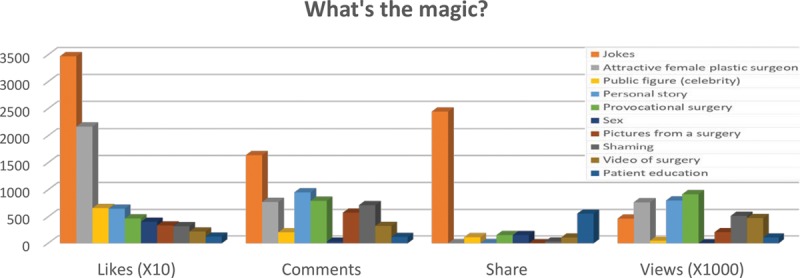
What attracts attention?
DISCUSSION
The Internet along with social media sites have become an integral part of modern society including the medical profession, prominent in the field of plastic surgery.4,5 Social media has become an important source of information for patients who expect personal medicine with an ongoing patient-physician relationship and instant online availability.3,13,14 As such, plastic surgeons have begun to adapt and are beginning to operate in this virtual world; however, most of the information on the Internet is far from being dominated by health care providers. For example, only 6% of the posts about plastic surgery on Twitter were published by plastic surgeons.1
In this study, 300 posts in English on Facebook, Instagram, and YouTube containing the key phrase “plastic surgery” were analyzed to elucidate the factors that attract attention to content about plastic surgery on social media.
Plastic surgeons lag behind in the growing competition for attention.16,17 Only a third of the posts analyzed in this study were written by plastic surgeons, with resembling findings in other studies.4,7,16 Most of the posts from plastic surgeons were published on Instagram, which is an excellent platform for reaching patients, perhaps because it is perceived as offering a more personal experience with less negative behavior like shaming compared with other social media sites. Instagram may also be less convenient for commercial use because companies tend to operate with a more business-minded approach and advertise (Fig. 1).
Unfortunately, educational posts and those about studies, accounted for only a small percentage of the total posts (16% and 2%, respectively) and generated only a little interest from the users. In contrast, using photographs of attractive women is still widely used, accounting for 68% of posts, and attracted much more attention than educational content (Fig. 6). Sadly, this controversial advertising is pervasive because it is still effective.17,18 As shown in Figure 8, attractive female plastic surgeons who post personal photographs on Instagram attract an incredible amount of attention. On the other hand, attractive male plastic surgeons generate less interest than their female counterparts (Table 1).
The phenomenon of shaming using the Internet and social media to publicly embarrass and insult others has become a major problem, particularly for plastic surgeons, that operate in a private, competitive market. Shaming is seen in 21% of the posts, mostly on Facebook (39%), and mainly relating to a public figure (25%; Fig. 2). However, it does not mean that plastic surgeons are exempt from ridicule. We noticed shaming of board-certified plastic surgeons when reviewing the posts, but it mainly occurred in the comments section and hence was not recorded. There is no need to elaborate on the hazards this tool entails.16,19–21
Table 2.
Top Do’s and Don’ts of Social Media for Plastic Surgeon
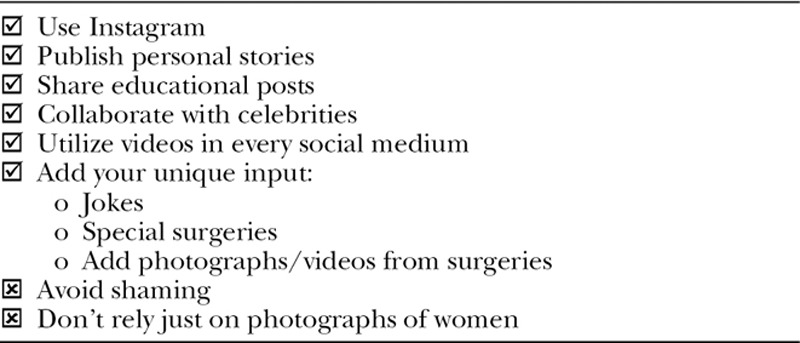
Some of the posts used reality television stars (7%) and were mainly on Facebook (17%). Reality television stars attracted a lot of attention, measured by “likes,” but this attention may not be as effective (measured also by comments and shares) as that of other public figures (Figs. 3, 4). Educational content using videos or pictures of surgeries may be worthy alternatives to using public figures (Fig. 8, Table 1). Notably, posts that include videos or aim to educate patients are rewarded by a substantially higher number of shares, perhaps because they resonant more with the target audience. Shares are a good way to pass information, as it is loyal to the original massage, posts with videos, in particular, draw more attention than posts without them (Fig. 7).
Interestingly, uniqueness in the form of humor or quirkiness was more likely to attract attention compared with the traditional advertising methods of using attractive women and/or celebrities in posts (Fig. 8).
Our study found that, per post, there were an average of 5,433 “likes,” 530 comments, 556 shares, and 875,943 views. Hence, social media is undoubtedly the future and a ground worth pursuing.
Whether a surgeon is a novice or an experienced user in the social media (networks), the main challenges of attracting the right public attention and picking the right media for each post still remain. Today’s plastic surgeons must understand their future patients to create social medial content that caters to their interests and attracts positive attention. Our study results may aid in this quest. For example, following our findings, the novice social media user can use Instagram as a tool for self-promotion, and YouTube as a convenient stage for educational content. The veteran user can add new strategies to their repertoire by adding jokes, personal stories of patients (upon consent), videos, or photographs of surgeries to attract more attention and educate the public.
Apart from the traditional ways to measure the success of a physician, tomorrow’s success, potential, and public influence of a surgeon might be measured by “social media currency” (“Likes”, comments, shares, and views). The potential of celebrities to attract attention (Fig. 5) can be harnessed to reach a larger audience. Notably, very few doctors were able to use social media effectively to attract large audiences by themselves. It may be wise to enlist the help of “social media celebrities,” which were shown in the study to attract as much attention as commercial companies.
A deep understanding of the power of media, both traditional and new, is vital for all those engaged in the competitive plastic surgery market to self-promote and connect with potential patients. In our opinion, it may be wise to establish a set of rules that will outline the proper way to act in this field,15,21,22 a place where negative influences, misinformation, and destructive phenomena such as shaming are a common occurrence.9,15,20–22 Uncoordinated activity may allow negative influences to take root. In summary, we can use these tools to our advantage to increase the board-certified plastic surgeon’s accessibility to the general public, according to established ethical rules, and to educate the public through evidence-based medicine.23,24
CONCLUSIONS
The Internet and social media networks are of great importance, especially in the field of plastic surgery. Plastic surgeons lag behind in the ever-increasing competition for attention, and they must find a way to utilize these tools for patient education, advertising and defense from inaccuracy and online shaming. These research findings may aid this journey by shedding light upon best practices with social media.
The study’s main insights were to use Instagram, personal stories, educational post, videos and other unique inputs, and involve celebrities in the posts.
As internet use and social media become ubiquitous, it is best to embrace these phenomena, along with exercising necessary precautions, so that they do not become a double-edged sword for users.
Footnotes
Published online 13 December 2018.
Disclosure: The authors have no financial interest to declare in relation to the content of this article. The Article Processing Charge was paid for by the authors.
REFERENCES
- 1.Branford OA, Kamali P, Rohrich RJ, et al. #Plasticsurgery. Plast Reconstr Surg. 2016;138:1354. [DOI] [PubMed] [Google Scholar]
- 2.Pew Research Centre. 2015 Statistics. Available at http://www.pewinternet.org/2015/10/08/social-networkingusage-2005–2015/. Accessed March 26, 2016.
- 3.Montemurro P, Porcnik A, Hedén P, et al. The influence of social media and easily accessible online information on the aesthetic plastic surgery practice: literature review and our own experience. Aesthetic Plast Surg. 2015;39:270. [DOI] [PubMed] [Google Scholar]
- 4.Mabvuure NT, Rodrigues J, Klimach S, et al. A cross-sectional study of the presence of United Kingdom (UK) plastic surgeons on social media. J Plast Reconstr Aesthet Surg. 2014;67:362. [DOI] [PubMed] [Google Scholar]
- 5.McEvenue G, Copeland A, Devon KM, et al. How social are we? A cross-sectional study of the website presence and social media activity of Canadian Plastic Surgeons. Aesthet Surg J. 2016;36:1079. [DOI] [PubMed] [Google Scholar]
- 6.Klee D, Covey C, Zhong L. Social media beliefs and usage among family medicine residents and practicing family physicians. Fam Med. 2015;47:222. [PubMed] [Google Scholar]
- 7.Loeb S, Bayne CE, Frey C, et al. ; American Urological Association Social Media Work Group. Use of social media in urology: data from the American Urological Association (AUA). BJU Int. 2014;113:993. [DOI] [PubMed] [Google Scholar]
- 8.Jejurikar SS, Rovak JM, Kuzon WM, Jr, et al. Evaluation of plastic surgery information on the Internet. Ann Plast Surg. 2002;49:460. [DOI] [PubMed] [Google Scholar]
- 9.Gordon JB, Barot LR, Fahey AL, et al. The Internet as a source of information on breast augmentation. Plast Reconstr Surg. 2001;107:171. [DOI] [PubMed] [Google Scholar]
- 10.Malberger OM, Rafaeli S, Waisman D, et al. Media selection for the announcement of childbirth-The social capital aspect. 2013;The Third International Conference on Digital Information and Communication Technology and its Applications (DICTAP2013) The Society of Digital Information and Wireless Communication; 12. [Google Scholar]
- 11.Malberger O, Rafaeli S, Weisman D. Media Selection for the Announcement of Child Birth: Who Will be the First to Receive a Phone Call Once a New Baby is Delivered? Will it be a Phone Call? An SMS? And Why…?. 2015Lap Lambert Academic Publishing. [Google Scholar]
- 12.Dauwe P, Heller JB, Unger JG, et al. Social networks uncovered: 10 tips every plastic surgeon should know. Aesthet Surg J. 2012;32:1010. [DOI] [PubMed] [Google Scholar]
- 13.Fox S. Peer-to-peer Healthcare. PewResearch Internet Project. 2011Available at http://www.pewinternet.org/2011/02/28/peer-to-peer-healthcare-2/.
- 14.Domanski MC, Cavale N. Self-reported “worth it” rating of aesthetic surgery in social media. Aesthetic Plast Surg. 2012;36:1292. [DOI] [PubMed] [Google Scholar]
- 15.Sorice SC, Li AY, Gilstrap J, et al. Social media and the plastic surgery patient. Plast Reconstr Surg. 2017;140:1047. [DOI] [PubMed] [Google Scholar]
- 16.Camp MC, Wong WW, Mussman JL, et al. The battle for hearts and minds: who is communicating most effectively with the cosmetic marketplace? Aesthet Surg J. 2010;30:614. [DOI] [PubMed] [Google Scholar]
- 17.Mary M, Gentry J. Stuck in the model trap: the effects of beautiful models in ads on female pre-adolescents and adolescents. J Advertis. 1997;26:19. [Google Scholar]
- 18.Kilbourne J. Killing us softly 4: advertising’s image of women [Trailer]. Available at YouTube. https://www.youtube.com/watch?v=PTlmho_RovY&feature=player_embedded.
- 19.Rohrich RJ, Weinstein A. Paging Dr. Google: the changing face of plastic surgery. Plast Reconstr Surg. 2016;138:1133. [DOI] [PubMed] [Google Scholar]
- 20.Liu DZ. Commentary on: a primer on social media for plastic surgeons: what do I need to know about social media and how can it help my practice? Aesthet Surg J. 2017;37:620. [DOI] [PubMed] [Google Scholar]
- 21.Dorfman R, Vaca E, Eitezaz M, et al. Plastic surgery-related hashtag utilization on instagram: implications for education and marketing. Aesthet Surg J. 2017;37:614. [DOI] [PubMed] [Google Scholar]
- 22.Dorfman RG, Vaca EE, Fine NA, et al. The ethics of sharing plastic surgery videos on social media: systematic literature review, ethical analysis, and proposed guidelines. Plast Reconstr Surg. 2017;140:825. [DOI] [PubMed] [Google Scholar]
- 23.Gould DJ, Nazarian S. Social media return on investment: how much is it worth to my practice? Aesthet Surg J. 2018;38:565. [DOI] [PubMed] [Google Scholar]
- 24.Gould DJ, Grant Stevens W, Nazarian S. A primer on social media for plastic surgeons: what do I need to know about social media and how can it help my practice? Aesthet Surg J. 2017;37:614. [DOI] [PubMed] [Google Scholar]


